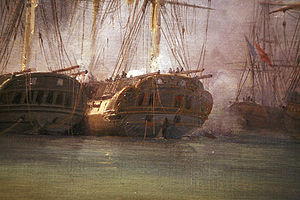French frigate Minerve (1809)
 Minerve (centre) at the Battle of Grand Port.
| |
| History | |
|---|---|
| Name | Nossa Senhora da Vitória, a Minerva;[2] Minerva[1] |
| Namesake | Minerva |
| Builder | Lisbon[1] |
| Laid down | 1787[1] |
| Launched | 19 July 1788[1] |
| Captured | 23 November 1809 |
| Name | Minerve |
| Acquired | 22 November 1809 |
| Captured | 3 December 1810 by the Royal Navy |
| Status | Broken up |
| General characteristics | |
| Tons burthen | 1400 tons [1] |
| Length | 47.78 m (total) [1] |
| Beam | 11.58 m [1] |
| Complement | 349 men [1] |
| Armament | 48 guns, 18-pounder main battery [1] |
Minerve was the 48-gun Portuguese Navy frigate Nossa Senhora da Vitória, a Minerva, launched in 1788. The French captured her in November 1809 off India and took her into service as Minerve. The British captured her shortly thereafter and had her broken up.
Career
N.a S.a da Vitória, a Minerva spent the first almost two decades of her career guarding Portuguese waters. In 1807 she was part of the flotilla involved in the transfer of the Portuguese Court to Brazil.[2]
In November 1809 Minerva sailed to Brazil, under Captain Pinto.[3]
On 22 November 1809 she encountered the French frigate Bellone, under Captain Duperré. The distance between the two ships being too great for Duperré to catch them before nightfall, he shadowed Minerva until the next morning. On 23, at 9:00, Bellone had taken a favourable position behind Minerva, at pistol range. Understanding the advantage that this configuration gave to Bellone, Pinto turned, but the French followed and fired a raking broadside. Pinto then turned the other way, only to receive another broadside. Eventually, Minerva ran downwind, but Bellone followed and maintained fire, until Minerva surrendered. The fight had lasted for one hour and forty-five minutes.[4]
Minerve
The French commissioned Minerva as Minerve, and appointed Pierre Bouvet as her captain.[5] Duperré, hindered by the damage Bellone had sustained, the reduction and dispersion of his crew over his prizes, and the 500 prisoners he had aboard, decided to return to Île de France, where he arrived on 2 January 1810, accompanied by Manche, which they had met en route.
At Île de France the French repaired Minerve and replaced her carronades with 18-pounder short guns.[5]
Minerve and Manche then sailed together, capturing the East Indiamen Windham and Ceylon in the Action of 3 July 1810. On their return to Île de France, the squadron fought in the Battle of Grand Port.
Minerve was surrendered to the British after the Invasion of Île de France in December 1810, and was broken up shortly thereafter.
Notes and references
Notes
References
Bibliography
- Demerliac, Alain (1996) La Marine De Louis XVI: Nomenclature Des Navires Français De 1774 À 1792. (Nice: Éditions OMEGA). ISBN 2-906381-23-3
- Esparteiro, Comandante António Marques (1976) Catálogo Dos Navios Brigantinos (1640-1910). (Lisbon: Centro de Estudos de Marinha)
- Roche, Jean-Michel (2005). Dictionnaire des bâtiments de la flotte de guerre française de Colbert à nos jours, 1671 - 1870. Group Retozel-Maury Millau. ISBN 978-2-9525917-0-6. OCLC 165892922.
- Troude, Onésime-Joachim (1867). Batailles navales de la France. Vol. 4. Challamel ainé. pp. 160–162.
- (in French) Les bâtiments ayant porté le nom de Minerve, netmarine.net
